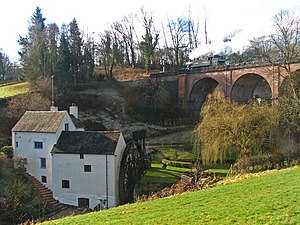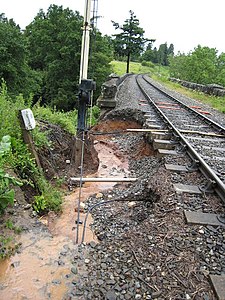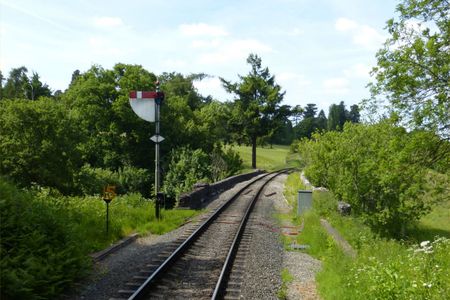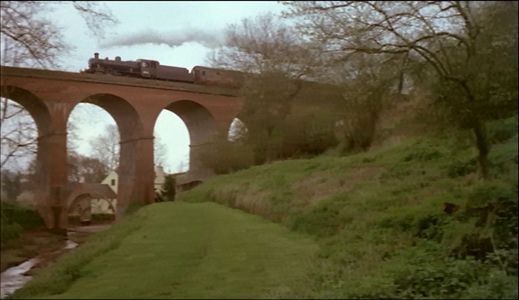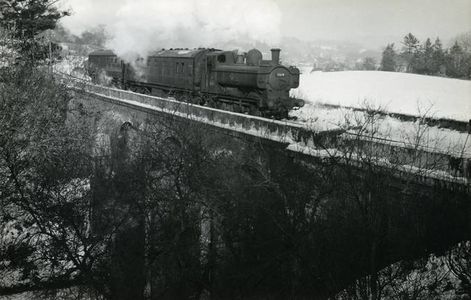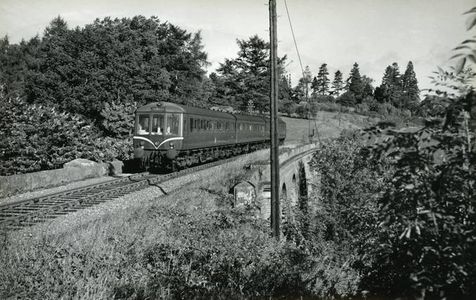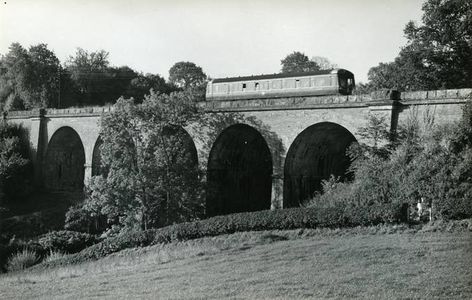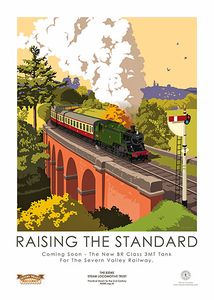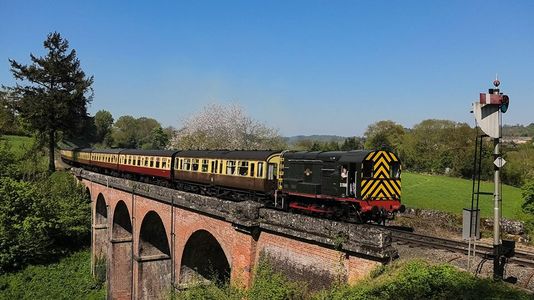Oldbury Viaduct (Bridge 33) is situated a short way south of Bridgnorth on the ascent towards Knowlesands Tunnel and the summit of Eardington Bank. The viaduct, which like the other viaducts on the railway was built wide enough for dual tracks, is constructed of red brick with a sandstone parapet, and has five arches each with a 33ft span. It carries the SVR over a small valley where a stream runs past Daniel's Mill. After closure of the section of line, BR engineers intended to demolish the structure but were refused permission by the then mill owner Alan George, a supporter of the railway and one of the founder members of the Severn Valley Railway Society[1].
Contents
Preservation era
On 25 March 1967 the SVR's first locomotive, 3205, arrived together with four carriages, beginning a three day event during which the locomotive and two carriages made trips as far as the viaduct and back.[2] Later open days in the 1960s saw running all the way to Hampton Loade, the track still being owned by BR at the time.
The viaduct was eventually acquired by the SVR in 1970 as part of the north section of the line between Bridgnorth and Alveley Sidings. During 1972 the Civil Engineering Department[note 1] began a programme of work on the structures between Bridgnorth and Hampton Loade. Inspection of the viaduct revealed that the drainage was not functioning properly, resulting in rain water seeping into the brickwork of the piers rather than issuing from the weep holes under the arches. The water had then frozen during past winters, breaking a large number of bricks which had then fallen out of the piers, the central one being in especially bad condition. The department decided to repair the brickwork at the time but to tackle the drainage at a later date when the line was closed. Work began on 20 August 1972 with the erection of a scaffold frame which was suspended over the viaduct, one end being fastened to the running lines. From this, two winches were suspended and connected to painters' cradles. During the following weeks, many bricks were removed and replaced with new engineering bricks.[3]
A substantial rebuild of the viaduct was carried out by the Civil Engineering Department over the winter of 1975-76. The running season had been extended by two weeks, meaning work could not begin until 1 December. The ballast was excavated out to reveal the arch buttresses and side walls. Inspection revealed that the side walls were moving away from the arches. The gaps were filled, after which the arch and side walls were drilled and heavy steel brackets used to join them together by concreting bolts into the holes. New drains were installed to allow water to run away through the side walls of the viaduct, which were drilled to accommodate a 4-inch PVC pipe. The tops of the arches were sealed by pouring concrete to form a 9-inch slab, and the piers were then sealed in turn by laying heavy gauge polythene sheet on a bitumastic layer, covering this with a thick layer of sand, and back filling again with limestone up to arch level. Finally, the ballast and track were replaced. The work was eventually completed within the planned timescale, although two weeks behind schedule due to the delay of the start of the project.[4]
On the night of the first 2007 storm, the volume of water flowing down the stream under the viaduct caused serious damage to the water wheel and associated equipment at Daniel's Mill. The viaduct itself was undamaged, although water running down the railway caused a washout at the south (Hampton Loade) end of the viaduct next to the Bridgnorth Outer Home Signal which undermined the trackbed on the west side of the line (pictured). Over the next few weeks it also became apparent that the face of the valley to the east of the line between the viaduct and Daniel's Mill was starting to subside, putting the south end of the viaduct at risk of failure.
The recovery work at the viaduct began by carrying out exploratory test bores to determine the underlying ground conditions so that an appropriate permanent solution could be designed. This mainly comprised installing a contiguous bored-pile retaining wall on the east side of the line, which required 25 piles up to 10 metres deep linked by a concrete cap. New drainage was also installed on both sides of the line consisting of vertical linked chambers which would collect water from the uphill side of the viaduct via a network of perforated pipes, with any water collected being piped down to the bottom of the valley.[5] The picture below shows a view of the south end of the viaduct in 2015 with the cap of the retaining wall and a cover for part of the drainage system visible to the right of the line. Other repair work is also visible to the left of the line next to the speed limit sign.
Film and television
The viaduct has made brief appearances in several films and television series, including:
- The Seven-Per-Cent Solution: The Pasha's train is seen crossing the viaduct northbound as Holmes and Baron von Leinsdorf duel with rapiers on the rooftops of the Ottoman salon carriages[6]
- The Thirty Nine Steps (1978); LMS Ivatt Class 2 46443 (in MR livery as No 644) crosses the viaduct travelling north.
- God's Wonderful Railway (1979); 7819 Hinton Manor crosses the viaduct with a passenger service
- The Chronicles Of Narnia (2005); during the title sequence the Pevensie children's evacuation train headed by 7802 Bradley Manor is seen crossing the viaduct southbound.[7].
Photography
The viaduct features in a number of pictures from the Sellick Collection.
Ex-GWR Pannier 3619 crosses Oldbury Viaduct in January 1963 (Sellick Collection)
A DMU crosses Oldbury Viaduct in September 1962 (Sellick Collection)
A view of Oldbury Viaduct from the East in September 1962 (Sellick Collection)
It is regularly seen in publicity material and used as a photographic location, particularly with pictures of locomotives seen from the hill above the viaduct to the west of the line. However it should be noted that although there are public footpaths underneath the viaduct at the bottom of the valley, the area above the viaduct from which such photographs are taken is private land and not accessible to the general public.
See also
Notes
- ↑ During the 1970s there were separate "Permanent Way" and "Civil Engineering" Departments
References
- ↑ Marshall (1989) p. 104.
- ↑ Marshall (1989) pp. 168-9.
- ↑ SVR News 26
- ↑ SVR News 39, 40
- ↑ Sowden (2012) pp. 5-7.
- ↑ Reelstreets website (Retrieved 26 August 2019)
- ↑ Movie Locations website (Retrieved 26 August 2019)
